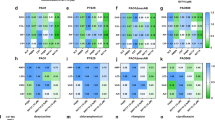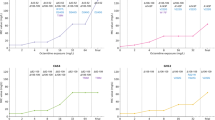Abstract
Resistance and the development thereof inPseudomonas aeruginosa to the bactericide sodium dimethyldithiocarbamate (SMT) was investigated.P. aeruginosa was cultured in nutrient-poor broth in the presence of subinhibitory concentrations of SMT. It adapted over 21 days of exposure from 250 μg·ml−1 to 490 μg·ml−1. The initial high MIC was ascribed to exclusion of SMT by the lipopolysaccharide layer, since removal thereof by EDTA rendered cells highly susceptible. The alginate-producing mutant PAO 579 was much more susceptible to SMT than was its parent PAO 381, indicating that extracellular polysaccharide does not act as an exclusion barrier to SMT. Following 24 h of exposure to SMT,P. aeruginosa had an altered profile of outer membrane proteins as determined by SDS-PAGE. Resistant cells had a further altered profile. Resistance ofP. aeruginosa is ascribed to a change in the outer membrane protein profile, leading to improved exclusion of SMT.
Similar content being viewed by others
Literature Cited
Bell A, Bains M, Hancock REW (1991)Pseudomonas aeruginosa outer membrane protein Opr H: expression from the cloned gene and function in EDTA and gentamicin resistance. J Bacteriol 173:6657–6664
Brözel VS, Cloete TE (1991a) Fingerprinting of water treatment bactericides in South Africa. Water SA 17:57–66
Brözel VS, Cloete TE (1992b) Resistance of bacteria from cooling waters to bactericides. J Ind Microbiol 8:273–276
Brözel VS, Cloete TE (1992) The effect of bactericide treatment on planktonic bacterial communities in water cooling systems. Water SA 18:87–92
Cloete TE, Brözel VS, Pressly J (1989) A bacterial population structure study of water cooling systems in South Africa. Water SA 15:37–42
Cloete TE, Brözel VS, Von Holy A (1992) Practical aspects of biofouling control in industrial water systems. Int Biodeterior and Biodegrad 29:299–341
Deretic V, Dikshit R, Konyecsni WM, Chakrabarty AM, Misra TK (1989) Thealg R gene, which regulates mucoidy inPseudomonas aeruginosa, belongs to a class of environmentally responsive genes. J Bacteriol 171:1278–1283
Eagon RG, Barnes CP (1986) The mechanism of microbial resistance to hexahydro-1,3,5-triethyl-S-triazine. J Ind Microbiol 1:113–118
Escher A, Characklis WG (1990) Modeling the initial events in biofilm accumulation. In: Characklis WG, Marshall KC (eds) Biofilms. New York: John Wiley and Sons, pp 445–486
Gilbert P, Wright N (1987) Non-plasmidic resistance towards preservatives of pharmaceutical products. In: Board RG, Allwood MC, Banks JG (eds) Preservatives in the food, pharmaceutical and environmental industries. Oxford: Blackwell Scientific Publications, pp 255–279
Hancock REW, Carey AM (1979) Outer membrane ofPseudomonas aeruginosa: heat- and 2-mercaptoethanol-modifiable proteins. J Bacteriol 140:902–910
Hancock REW, Siehnel R, Martin N (1990) Outer membrane proteins ofPseudomonas aeruginosa. Mol Microbiol 4:1069–1075
Heinzel M (1989) The phenomena of resistance to disinfectants and preservatives. In: Payne KR (ed) Industrial biocides. Chichester: John Wiley and Sons, pp 52–67
Jones MV, Herd TM, Christie HJ (1989) Resistance ofPseudomonas aeruginosa to amphoteric and quaternary ammonium biocides. Microbios 58:49–61
Kolawole DO (1984) Resistance mechanisms of mucoidgrownStaphylococcus aureus to the antibacterial action of some disinfectants and antiseptics. FEMS Microbiol Lett 25:205–209
Laemmli UK, Favre M (1973) Maturation of the head of bacteriophage T4: 1. DNA packaging events. J Mol Biol 80:575–599
LeChevallier MW, Cawthon CD, Lee RG (1988) Inactivation of biofilm bacteria. Appl Environ Microbiol 54:2492–2499
Lowry OH, Rosebrough NJ, Farr AL, Randall RJ (1951) Protein measurement with the folin phenol reagent. J Biol Chem 193:265–275
Nikaido H, Vaara M (1987) Outer membrane. In: Neidhardt FC, Ingraham JL, Low K, Magasanik B, Schaechter M, Umbarger HE (eds)Escherichia coli andSalmonella typhimurium: cellular and molecular biology, Vol 1. Washington D.C.: American Society for Microbiology, pp 7–22
Preston MA, Penner JL (1987) Structural and antigenic properties of lipopolysaccharides from serotype reference strains ofCampylobacter jejuni. Infect Immun 55:1806–1812
Pugsley AP, Moreno F, De Lorenzo V (1986) Microcin-E-492-insensitive mutants ofEscherichia coli K12. J Gen Microbiol 132:3253–3259
Quinn JP, Dudek EJ, DiVincenzo CA, Lucks DA, Lerner SA (1986) Emergence of resistance to imipenem during therapy forPseudomonas aeruginosa infections. J Inf Dis 154:289–294
Reasoner DJ, Geldreich EE (1985) A new medium for the enumeration and subculture of bacteria for potable water. Appl Environ Microbiol 49:1–7
Reynolds EF (ed) (1989) Martindale, the extra pharmacopoeia, 29th edn. London: The Pharmaceutical Press
Sakagami Y, Yokohama H, Nishimura H, Ose Y, Tashima T (1989) Mechanism of resistance to benzalkonium chloride byPseudomonas aeruginosa. Appl Environ Microbiol 55:2036–2040
Tsai CM, Frasch CE (1982) A sensitive silver stain for detecting lipopolysaccharides in polyacrylamide gels. Anal Biochem 119:115–119
Author information
Authors and Affiliations
Rights and permissions
About this article
Cite this article
Brözel, V.S., Cloete, T.E. Resistance ofPseudomonas aeruginosa to sodium dimethyldithiocarbamate by adaptation. Current Microbiology 26, 275–280 (1993). https://doi.org/10.1007/BF01575917
Issue Date:
DOI: https://doi.org/10.1007/BF01575917




